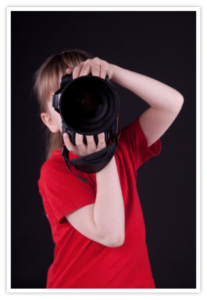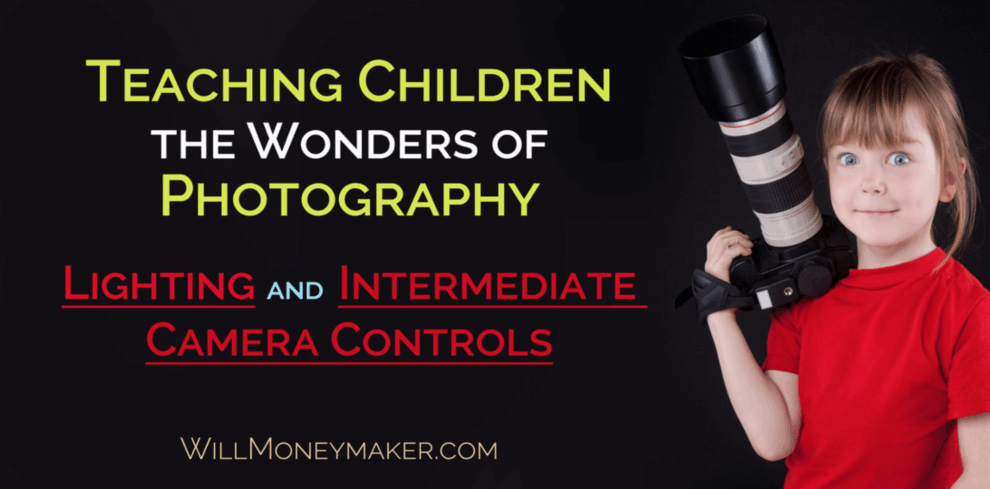Last time, I talked about some of the most basic things that a child will need to know as they learn how to be a photographer. This week, let’s dive a little deeper into the topic by showing you some of the more advanced things that should be taught next. Some of these advanced topics include lighting, the camera’s shutter speed, aperture, and ISO controls. As you go through this lesson, remember that the things I'll be discussing here are a bit more advanced, so make sure that you and the children that you are teaching take plenty of time to learn each lesson thoroughly!
Teaching Children How to Make Use of Available Lighting
The first thing that kids will need to know when it comes to light is how to put different kinds of light to work. Whether the child is shooting outside in the sunlight or indoors near a lamp, they'll need to be aware of where the light is coming from and how that will affect their image. In general, when dealing with available lighting, there are four different types that each child will need to learn about:
- Front Lighting: This is when the light source is in front of the subject (coming from behind the photographer). Front lighting lights up a subject very well, but bright front lighting may cause long shadows behind the subject.
- Side Lighting: Side lighting is light that comes from one side of the subject. This type of lighting is often used to add a moody look to a photo because it tends to cast shadows across the front of the subject. Think of it this way: If you take a photograph of a person with the sun to that person’s right side, you'll often find that the left side of that person’s face is shadow because it isn't in direct sunlight.
- Backlighting: Backlighting can be difficult to work with, particularly for children who don't yet understand the intricacies of lighting. A backlit subject is one that is photographed with the light behind the subject. Without fill-flash, this normally results in a dark, shadowy subject or a silhouette if the backlight is bright enough.
- Diffused Lighting: For a beginner, this is the easiest type of lighting to work with. Diffused lighting occurs when the light doesn't appear to be coming from any given direction, such as the light outdoors on an overcast day. Typically, there are few, if any, shadows when you shoot with diffused lighting, but as any advanced photographer knows, you also miss out on the golden quality of sunlight when you shoot on a cloudy day.
The best way to help a child master these types of lighting is to instruct them to take photos of the same subject — a parent, for instance — in each type of light. Then, have those photos printed and lay them out so that the child can see the differences in each photo.
As you're teaching children about lighting, you may also want to show them how to use the on-camera flash, too. This is another example of front lighting, which means that it will not only give children a better idea of how lighting works, but it will also help pave the way for the next lesson, which is to learn a bit more about some of the camera’s more advanced controls.
Shutter Speed, Aperture, and ISO
These controls are some of the next most important things to learn about. If you like, you can teach about each one of these controls using the priority modes — shutter priority mode and aperture priority mode. This often simplifies the learning process so that the child learns about each different control separately, allowing them to put all of this information together later on.
 I recommend shutter speed as the first control to teach because I feel that it is the easiest concept to understand. To teach shutter speed, instruct the child to take photographs at faster and slower shutter speeds to show them how the slower speeds produce brighter images while the faster speeds produce darker images. Once the child sees this, then you can explain that the shutter speed is simply a measurement of the amount of time that the camera’s shutter is open. The larger that bottom number of the fraction is, the faster the shutter will move.
I recommend shutter speed as the first control to teach because I feel that it is the easiest concept to understand. To teach shutter speed, instruct the child to take photographs at faster and slower shutter speeds to show them how the slower speeds produce brighter images while the faster speeds produce darker images. Once the child sees this, then you can explain that the shutter speed is simply a measurement of the amount of time that the camera’s shutter is open. The larger that bottom number of the fraction is, the faster the shutter will move.
When the child has a firm grasp on shutter speeds, move on to the aperture controls. This is a little bit confusing to explain: A wider aperture lets in more light, but wider apertures are notated with smaller numbers. As with the lesson on shutter speed, instruct the child to take a series of images with wide apertures and narrow ones to show them how this affects the brightness or darkness of the photo. There is no need to go into the specifics about depth of field here. Instead, just make sure that the child is comfortable with how both shutter speed and aperture affect the image’s lighting.
The final lesson to teach is about the camera’s ISO setting. Now, this can be a very complex subject, but for now, simply show the child how ISO affects lighting. You don't necessarily need to discuss the technical aspects of how ISO settings affect the camera’s sensor.
The first thing that a child needs to learn about ISO settings are that they are an adjustment that you make as a last resort. Adjust shutter speed and aperture first, leaving the ISO setting on its lowest number. Then, if the picture is still underexposed, you can raise the ISO setting — but be careful, because high ISOs can create a lot of noise. To illustrate this concept, it is a wise idea to take a picture at the camera’s lowest ISO setting and another at the camera’s highest ISO setting so that the child can look at the images and understand how high ISOs degrade picture quality.
Photography is a complex art form, and there is a lot more to teach, so I will be back next week with the third installment of this series!





